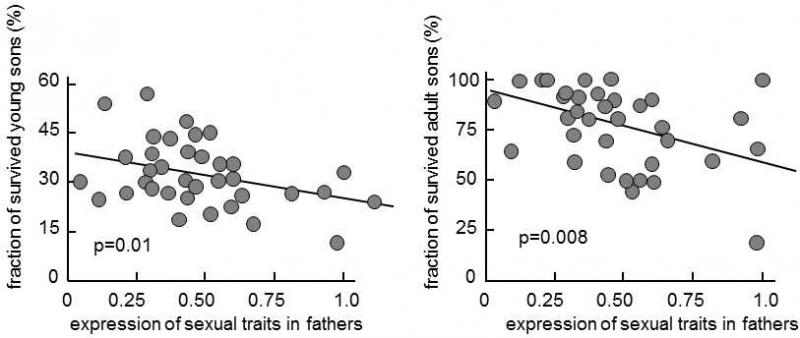XV.4.1 Species with more apparent sexual dimorphism exhibit higher male mortality
It follows from the different reproductive strategy of males and females that males are generally exposed to more intense sexual selection than females. Consequently, amongst them, we frequently encounter the presence of more obvious secondary sexual traits, of which it is generally assumed that they emerge through the action of sexual selection. A number of authors have attempted to determine the degree to which secondary sexual traits affect the viability of their bearers by comparing the viability of males and females. For example, it has been shown that males of wapiti elk (Cervus canadensis) succumb more readily to starvation than females, and African buffalo (Syncerus caffer) males are endangered more by lions (Cluttonbrock, Guenness, & Albon 1982; Prins & Iason 1989).
Two approaches can be used for systematic study of this problem. The first approach is based on intraspecies comparative studies entailing determination of the size correlation between the viability of individuals of a certain species and the expression of secondary sexual traits. These studies have been performed especially on birds and mammals and the results obtained demonstrated in a great many cases that the individuals with greater expression of secondary sexual traits also exhibited greater mortality in maturity. In some cases, their offspring also exhibited greater mortality even though the trait was not yet expressed (Brooks 2000).
The second approach is based on comparison of the properties of the individual species within a certain taxon. The method of interspecific comparison (Harvey & Pagel 1998)has been used, for example, for birds and mammals. Mostly, it was confirmed that species in which the males exhibit stronger secondary sexual traits also exhibit, on an average, greater mortality of males compared to females. (However, in some cases, the authors obtained negative results (Owens & Bennett 1994).)
The results of comparative studies have shown that sexual selection can come into conflict with environmental selection and that secondary sexual traits frequently reduce the viability of their bearers.

Fig. XV.2 Negative correlation between the degree of expression of a secondary sexual trait and the viability of male guppies. In guppies (Poecilia reticulata) the variety and intensity of the pattern on the males is one of the most important indicators of success in intrasex competition and is thus an object of intense sexual selection. However, under the experimental conditions, a negative correlation was found between the intensity and richness of the pattern on a male (expressed in the graph in relative values) and the percentage of his sons that survived to maturity (a) and also between the intensity and richness of the pattern on a male and the percentage of adult males that survived another 6 months after reaching maturity (b). Simultaneously, no similar correlation was observed between the intensity and richness of the pattern on the father and the viability of his daughters. According to Brooks (2000).
